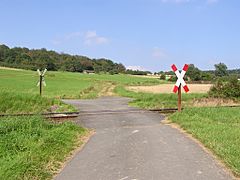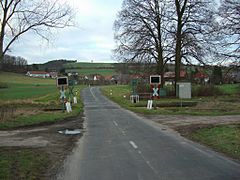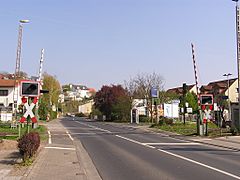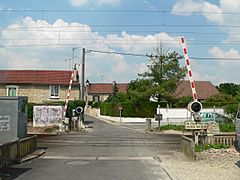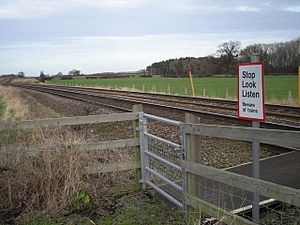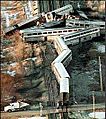Level crossing facts for kids
A level crossing is a place where a railway track and a road cross each other on the same level. This means they are not separated by a bridge or a tunnel. You will usually see signs telling you about the crossing. Sometimes there are also gates or barriers that close before a train comes.
Different safety measures are used depending on how busy the crossing is:
- Signs or panels warn you about the crossing.
- Lights might blink or stay steady.
- Sounds, like a warning bell, often ring.
- Gates or barriers lower to block the road when a train is near.
Level crossings can be dangerous, and accidents can happen. Because of this, they are often changed to have a bridge or tunnel when there is a lot of traffic or when high-speed trains use the tracks.
Contents
Examples of Level Crossings
-
An unsecured crossing shown by a sign. This local railway line is in a countryside part of Germany.
Staying Safe at Level Crossings
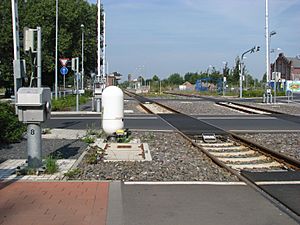
Trains are very heavy and need a long distance to stop. They cannot stop quickly like cars. Trains usually do not stop at level crossings. They depend on cars and people to be off the tracks before they arrive.
Level crossings are a big safety concern around the world. Every year, hundreds of people are sadly killed in accidents at these crossings. Accidents can happen with vehicles or with people walking. When a person is hit, it is more likely to be deadly. Young people (ages 5–19) and older people (60 and over) are at higher risk. Males are also considered high-risk users.
There are two main types of warning systems for road users. "Passive" protection uses signs to warn you. "Active" protection uses automatic devices. These include flashing lights, warning sounds, and barriers or gates. In the past, many crossings only had signs that said "Stop, look, and listen." Today, active systems are common. Fewer accidents happen at crossings with active warnings.
Modern radar sensors can check if the tracks are clear as a train gets close. This makes crossings safer. These sensors can stop barriers from closing if a car or person is stuck on the tracks. They can also tell the train to slow down if there is an obstruction.
At train stations, you might find a level crossing for people to walk across. This helps passengers reach other platforms if there is no underground tunnel or bridge. It also helps people with disabilities. If a railway uses a third rail for power, there is a gap in the rail at the crossing. Trains still get power because they have collectors on different parts of the train.
Related pages
Images for kids
-
A level crossing at Hoylake, Merseyside, England, UK with a train passing.
-
A railroad crossing in Abington, Massachusetts, US.
-
A level crossing in Padang, West Sumatra, Indonesia, with a Minangkabau Airport Rail Link train passing.
-
A level crossing in Senegal (2020).
See also
 In Spanish: Paso a nivel para niños
In Spanish: Paso a nivel para niños


